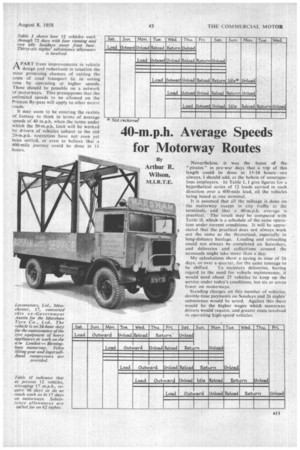40-m.p.h. Average Speeds for Motorway Routes
Page 45

If you've noticed an error in this article please click here to report it so we can fix it.
By
Arthur R. Wilson,
APART from improvements in vehicle design and reductions in taxation the most promising chances of cutting the costs of road transport lie in saving time by operating at• higher speeds. These should be possible on a network of motorways. This presupposes that the unlimited speeds to be allowed on the Preston By-pass will apply to other motor roads.
It may seem to be entering the realms of fantasy to think in terms of average speeds of 40 m.p.h. when the terms under which the 30-mph. limit will be worked by drivers of vehicles subject to the old 20-m.p.h. restriction have not even yet been settled, or even to believe that a 400-mile journey could be done in 11 hours. Nevertheless, it was the boast of the " pirates " in pre-war days that a trip of this length could be done in 15-16 hours—not always, I should add, at the behest of unscrupulous employers. In Table 1, I give figures for a hypothetical series of 12 loads carried in each direction over a 400-mile lead, all the vehicles being based at one terminal. .
It is assumed that all•the mileage is done on the motorway except in city traffic at the terminals, and that a 40-m.p.h. average is practical. The result may be compared with Table 11, which is a schedule of the sarrie operation under current conditions. it will be appreciated that the practical does not always work out the same as the theoretical, especially in long-distance haulage. Loading and unloading could not always be completed on Saturdays, and deliveries and collections around the terminals might take more than a day.
My calculations show a saving in time of 26 days, or over a quarter, for the same tonnage to be shifted. To maintain deliveries, having regard to the need for vehicle maintenance, it would need about 25 vehicles to keep up the service under today's conditions, but six or seven • fewer on motorways.
Standing charges on this number of vehicles, double-time payments on Sundays and 26 nights' subsistence would be saved. Against this there would be the higher wages which motorway drivers would require, and greater costs involved in operating high-speed vehicles.




































































































